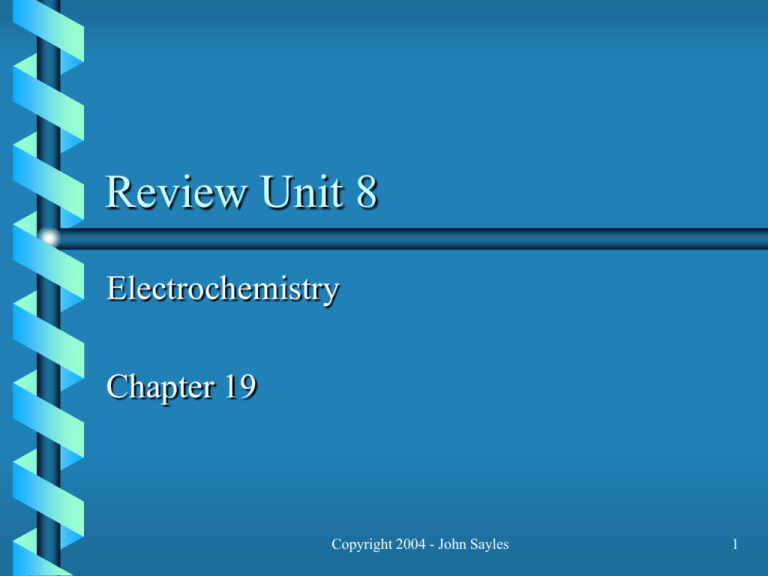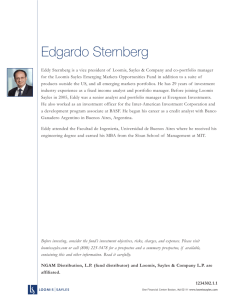
Review Unit 8
Electrochemistry
Chapter 19
Copyright 2004 - John Sayles
1
Oxidation Number
• Way to keep track of who gains and who loses e-’s
• A few elements have dependable ox #’s
– Group I metals always +1
– Group II metals always +2
– Lone halogens always -1
• +1, +3, +5, +7 in oxyradicals
– Oxygen usually -2
• Peroxide is O2-2
– Hydrogen usually +1
• Hydride is -1
• Valence of other elements is inferred
- John Sayles
– Total charge = sum Copyright
of ox2004#’s
2
Redox Terminology
• Oxidizing agent (high reduction potential)
– Yanks e- from other species, causing oxidation
– Is reduced
• Reducing agent (high oxidation potential)
– Forces e- on other species, causing reduction
– Is oxidized
• Anode is electrode where oxidation occurs
• Cathode is electrode where reduction occurs
Copyright 2004 - John Sayles
3
Balancing Redox Equations
• Split into half reactions
– Identify elements being oxidized & reduced
• Balance each half-reaction for atoms
–
–
–
–
For main element
For O’s, by adding H2O
For H’s, by adding H+
(neutralize H+’s by adding OH-’s to both sides)
• Balance for electrons by examining ∆ ox #’s
• Multiply and recombine to cancel e-’s
• Do chromate/Fe+2, permanganate/HCl
Copyright 2004 - John Sayles
4
Electromotive Force
• Can’t measure EMF of a half-cell, so we
must pick arbitrary standard
H2 -----> 2 H+ + 2 e-
E°red/ox = 0.00 volts
• Rules for manipulating E’s
Ered = - Eox
Edoubled = Esingle
Etotal = Ered + Eox
• E > 0 for spont. rxn, E = 0 at equilibrium
Copyright 2004 - John Sayles
5
Standard Electrode (Reduction) Potentials in Aqueous Solution
T19_1a
Cathode (Reduction)
Half-Reaction
Li +(aq) + eР
Р 2.71
Na( s)
Р
2+
Mg (aq) + 2e
Mg( s)
Р 2.38
Al3+(aq) + 3eР
Al(s)
Р 1.66
H2(g) + 2OH Р(aq)
Р 0.83
Zn (aq) + 2e
Zn( s)
Р 0.76
Cr3+(aq) + 3eР
Cr(s)
Р 0.74
Fe(s)
Р 0.41
Cd (aq) + 2e
Cd(s)
Р 0.40
Ni 2+(aq) + 2eР
Ni(s)
Р 0.23
Sn (aq) + 2e
Sn(s)
Р 0.14
Pb3+(aq) + 2eР
Pb(s)
Р 0.13
Fe(s)
Р 0.04
2H (aq) + 2e
H2(g)
Sn4+(aq) + 2eР
Sn2+(aq)
Cu+(aq)
Cu(s)
0.00
0.15
0.16
0.34
Р
2H 2O(l) + 2e
2+
Р
2+
Р
2+
Р
Fe (aq) + 2e
Р
2+
3+
Р
3+
Р
Fe (aq) + 3e
Cu2+(aq) + eР
Cu2+(aq) + 2eР
©
Р 3.04
Li(s)
Na +(aq) + eР
Copyright
Standard Potential,
Eј(V)
Table 19-1A
Houghton Mifflin Company. All rights reserved
Copyright 2004 - John Sayles
6
Standard Electrode (Reduction) Potentials in Aqueous Solution
T19_1b
Standard Potential,
Eј(V)
Cathode (Reduction)
Half-Reaction
IР(aq) + 2OH Р(aq)
IOР(aq) + H2O(l) + 2eР
Cu3+(aq) + eР
Cu(s)
0.52
I2(s) + 2eР
Fe3+(aq) + eР
2IР(aq)
Fe2+(aq)
0.54
2Hg( l)
0.80
Hg 22+(aq) + 2eР
Ag+(aq) + eР
0.77
0.80
Ag(s)
Hg 2+(aq) + 2eР
0.85
Hg( l)
CLO Р (aq) + H2O(l) +2eР
ClР (aq) + 2OH Р(aq)
2Hg 2+(aq) + 2eР
Hg 22+(l)
NO 3Р (aq) + 4H+(aq) + 3eР
Br2(l) + 2eР
NO(g) + 2H 2O(l)
MnO 4Р(aq) + 8H+(aq) + 5eР
H2O2(aq) + 2H+(aq) + 2eР
F2(g) + 2eР
©
1.23
2H 2O(l)
2Cr 3+(aq) + 7H2O(l)
2Cl Р (aq)
S2O82Р (aq) + 2eР
0.96
1.07
Cr2O72Р (aq) + 14H+(aq) + 2eР
Cl2(g) + 2eР
0.90
0.90
2Br Р(aq)
O2(g) + 4H+(aq) + 4eР
Copyright
0.49
1.33
1.36
Mn 2+(aq) + 4H2O(l)
1.49
1.78
2H 2O(l)
2.01
2SO 42Р(aq)
2.87
2FР(aq)
Table 19-1B
Houghton Mifflin Company. All rights reserved
Copyright 2004 - John Sayles
7
Voltaic Cells
• Spontaneous Redox reaction (E > 0 volts)
• Know how to sketch one
– Anode, cathode, salt bridge, flow of e-’s, ions
– Ex: Cu/Cu+2 || Ag+/Ag
• eV = energy needed to move an e- against a
potential difference of 1 volt
• Joule = energy needed to move a coulomb of e-’s
against 1 volt
– So Joule = coulomb volt
Copyright 2004 - John Sayles
8
Atomic View of A Voltaic Cell
Copyright
©
19-2
Houghton Mifflin Company. All rights reserved
Copyright 2004 - John Sayles
9
A Zinc-Copper Voltaic Cell
Copyright
©
19-3
Houghton Mifflin Company. All rights reserved
Copyright 2004 - John Sayles
10
Another Voltaic Cell
Copyright
©
19-4
Houghton Mifflin Company. All rights reserved
Copyright 2004 - John Sayles
11
Electrolytic Cells
• Nonspontaneous reaction (E < 0 volts)
• Reaction forced by supplying outside +EMF
in excess of E.
• Great way to count moles
– Amps x seconds = coulombs of e-’s
– 1 mole e-’s = 96,485 coulomb = 1 Faraday
– Consider moles e-’s in balanced half-reaction
Copyright 2004 - John Sayles
12
Electrolytic Half-cell Possibilities
• Anode possibilities
– Oxidize the anion
• Will happen unless anion is F-, SO4-2, NO3-
– Oxidize OH• Only in basic solution
• 2 OH- ----> 1/2 O2 + H2O + 2 e-
– Oxidize H2O
• Only if other two options are available
• H2O ----> 1/2 O2 + 2 H+ + 2 eCopyright 2004 - John Sayles
13
Electrolytic Half-cell Possibilities
• Cathode possibilities
– Reduce the cation
• Will happen unless cation is Gp I, Gp II, or Al+3
– Reduce H+ ions
• Only in acidic solution
• 2 H+ + 2 e- ----> H2
– Reduce H2O
• Only if other two options are not available
• H2O + e- ----> 1/2 H2 + OHCopyright 2004 - John Sayles
14
The Nernst Equation
• For calculating non-standard E’s
E = E° - RT/(n) ln Q
E = E° - .0257/n ln Q
• Also the basis for ion-selective electrodes
• pH probe sends voltage based on ∆ [H+]
• pH meter calculates [H+] and displays pH
Copyright 2004 - John Sayles
15
The Relationship Among K, ∆Gº, and Eº cell
19_7
Calorimetric
data
H ј, S ј
Gј = H ј - TS ј
Composition
data
Gј
Gј = - nFE ј cell
Electrochemical
data
E ј cell
Gј = - RT ln K
Eј cell =
RT
nF
lnK
Equilibrium
constants
K
Copyright
©
19-7
Houghton Mifflin Company. All rights reserved
Copyright 2004 - John Sayles
16






